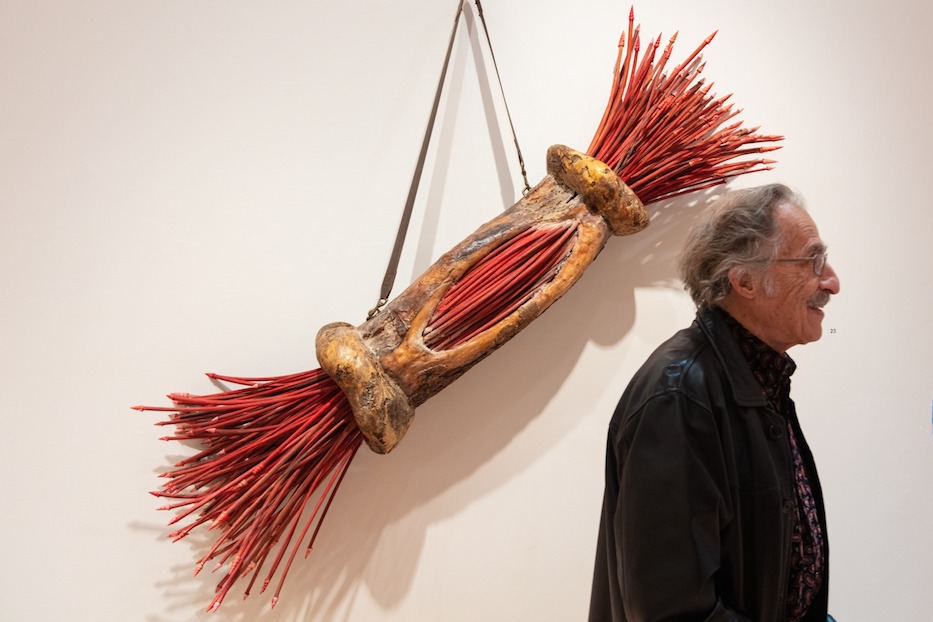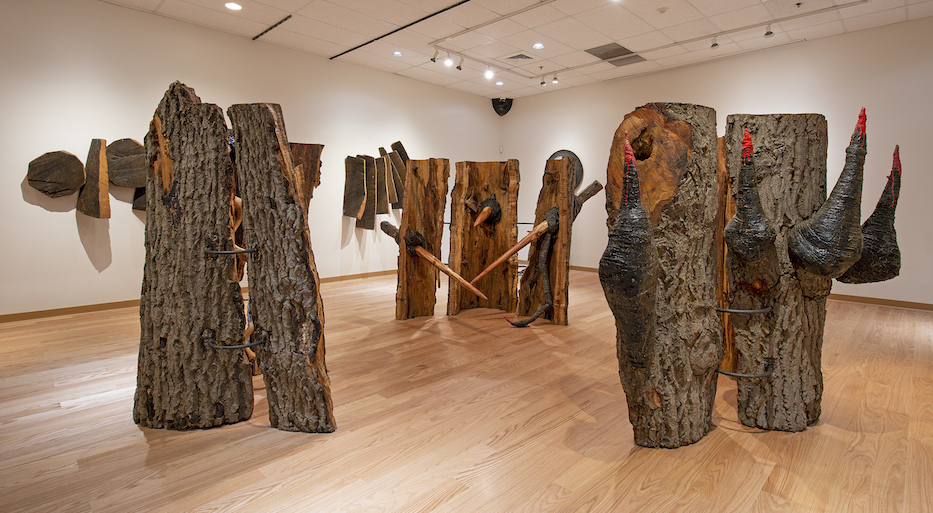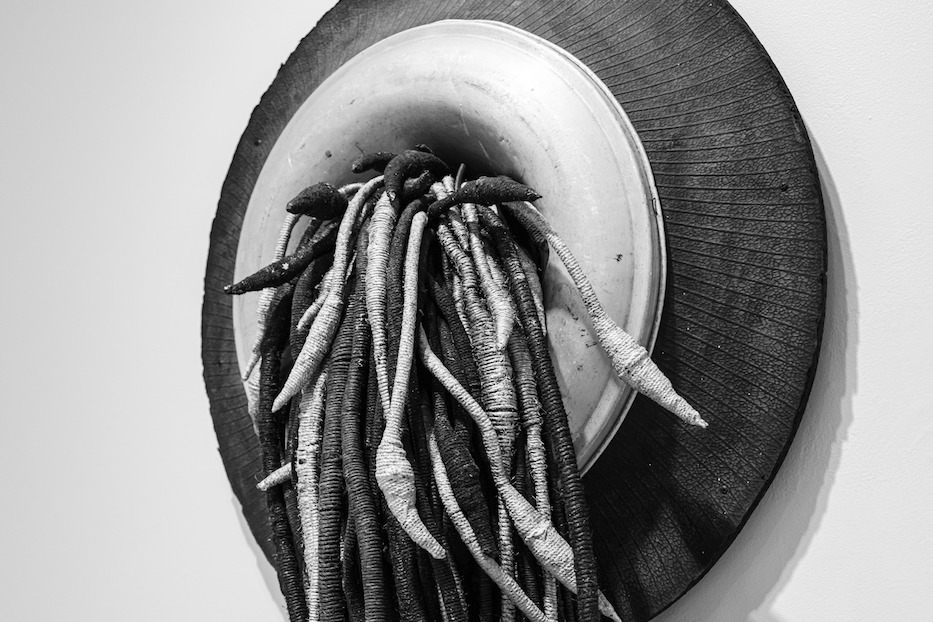
Bridgeport | Arts & Culture | Visual Arts | Sculpture

| Installation shot. Paul Mutino Photo. |
Bright red paint tinges a handful of peculiar growths on the outer edges of three sections of a large, hollowed-out tree trunk. Dripping down the sides, these streaks of paint evoke the striking presence of fresh blood. Inside a nearby sculpture—the second of three tripartite works collectively titled Henge by New Haven-based artist Joseph Saccio—wooden spikes pierce the sides of the tree in dramatic angles.
This triptych of sculptures, nearly six-feet tall, occupies a giant footprint within the second room of the gallery. It casts an ominous mood throughout the rest of Saccio's solo exhibition, In a Dark Wood, Wandering.
Grief pervades this collection of nearly two dozen works, covering over thirty years of Saccio’s career. This survey is the first—and likely the last—time these works will be exhibited as a whole during the artist’s life. Saccio celebrated his 85th birthday during the installation of the show, which runs through Dec. 14 in the Burt Chernow Galleries at the Housatonic Museum of Art.
A tragedy from Saccio’s life looms over the exhibition, though none of his emotionally raw works gathered for this occasion mention it directly. After the loss of his 12-year-old son in 1979, Saccio turned to art as a channel for his suffering. Initially, he worked alongside his daughter and son weaving his deceased son’s clothing into sculptures inside his first studio in an old factory along the Quinnipiac River. The mournful timbre of Saccio’s sculptures originates from this time and his personal experiences of death and rebirth.

| The artist with Quiver for St. Sebastian (2005). Hollow cherry tree trunk, cane, seashells, brass screening covered with tar, paint, beeswax, machine strap, brass fittings. Damijan Saccio Photo. |
The elegiac nature of Saccio’s works is magnified by the forcefulness of his craft. As a self-taught artist, Saccio brings emotional intensity to his practice. The heft and strength needed to break open the bodies of felled trees are evident in his muscular voice as a sculptor. Fragments are split and then cleaved together with steel armatures. Were his pieces more refined or constructed with greater precision, they would have lost their edginess. A more sophisticated treatment of his materials would have been at the expense of the work’s vulnerability.
Often, Saccio’s expressive hand becomes tempered by his lofty titles: many names do not point to the pain of the artist. Rather, distinct references are made to mythology, art history, as well as early Christian martyrs. His first career as a child psychiatrist seems to inform Saccio’s tendency to frame his work within myths, stories, and history.
In Mouth of Medusa from 1990, one of the earliest works in the show, a stream of wire-wrapped tubing spills out from a found metal object. Saccio relocates the serpentine hair of the Gorgon beast to the mouth of this sculpture, forging a connection between the deadly clutches of her hair and the seething force of words.
By contrast, Elegy for Clint: Homage to Motherwell draws from more recent history. In this piece, Saccio emulates the composition of one of the Elegies to the Spanish Republic, a series of over 100 oil paintings completed between 1948 and 1967. In Saccio’s iteration of the Abstract Expressionist canvases, the heaviness of Motherwell’s black shapes is translated into three-dimensional shards of black oak.

| Mouth of Medusa (1990). Mixed Materials: aluminum found object, wire, rubber tube, casing of electrical wire, sisal wrapping, tar, silver paint. Damijan Saccio Photo. |
Sliced by a chainsaw, these cumbersome oak slabs are mounted on the wall in high relief. Motherwell’s series was intended as a lamentation following the Spanish Civil War, and likewise, Saccio uses these works as a template to honor the life of one of his friends.
In many ways, the New York School artists are a fitting parallel for Saccio. Their fervor frequently came across as brute expression. The pursuit of the sublime through the eternal language of abstraction, characteristics shared among many of the works by the Abstract Expressionists, feels consistent in Saccio’s works, too.
Another form of memorialization can be seen in several works that refer to Saint Sebastian—the Roman Catholic patron saint of archers, athletes, and holy death. The perforated structure of the aforementioned sculpture within Henge, with its lanced sides, suggests this character, as does Quiver for St. Sebastian—by both its name and imagery. In this piece, Saccio assembles a bundle or red arrows.
The bold color and plenitude of the reeds topped with pointy seashells relate to the narrative of the early Christian martyr’s repeated impalement. His miraculous recovery has functioned as a metaphor for endurance and resilience since the 17th century when scenes of his life were immortalized in numerous paintings.
Taken as a whole, Saccio’s oeuvre has a somber quality. His materials—many of which are organic and as such, impermanent—link directly to the show’s themes of mourning and remembrance. Throughout his career, Saccio’s art has proven to be a powerful conduit of catharsis for the artist’s experiences with loss.
This approach to making art stems from a deeply personal place, but his willingness to share both pain and transcendence with an audience comes across as selfless. Despite the dark currents surging through his work, Saccio’s search for greater meaning from tragedy imparts a feeling of hope.
In a Dark Wood, Wandering runs through Dec. 14, 2019, at the Housatonic Museum of Art. To find out more about the museum’s hours and collection, visit its website.

